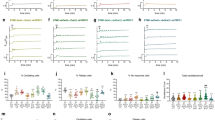Abstract
Mammalian transient receptor potential canonical (TRPC) genes encode a family of nonselective cation channels that are activated following stimulation of G-protein-coupled membrane receptors linked to phospholipase C. In Drosophila photoreceptor cells, TRP channels are found in large, multimolecular signaling complexes in association with the PDZ-containing scaffolding protein, INAD. A similar mammalian TRPC “signalplex” has been proposed, but has yet to be defined. In the present study, affinity-purified polyclonal antibodies against TRPC5 and TRPC6 were used to immunoprecipitate signalplex components from rat brain lysates. Immunoprecipitated proteins were separated by sodium dodecyl sulfate-polyacrylamide gel electrophoresis, digested with trypsin, and sequenced by mass spectrometry. Proteins identified in the immunoprecipitates included cytoskeletal proteins spectrin, myosin, actin, drebrin, tubulin, and neurabin; endocytic vesicle-associated proteins clathrin, dynamin and AP-2; and the plasmalemmal Na+/K+-ATPase (NKA) pump. Several of these interactions were confirmed by reciprocal immunoprecipitation followed by Western blot analysis. In lysates from rat kidney, TRPC6, but not TRPC3, was found to coimmunoprecipitate with the NKA pump. Likewise, TRPC6, stably expressed in human embryonic kidney (HEK) cells, coimmunoprecipitated with endogenous NKA and colocalized with the pump to the plasmalemma when examined by immunofluorescence microscopy. Cell surface biotinylation experiments in intact HEK cells, confirmed that both the Na+ pump and TRPC6 were present in the surface membrane and appeared to interact. Lastly, TRPC6 coimmunoprecipitated with the NKA pump when the proteins were coexpressed in Spodoptera frugiperda insect cells using recombinant baculoviruses. These observations suggest that TRPC6 and the Na+ pump are part of a functional complex that may be involved in ion transport and homeostasis in both the brain and kidney.











Similar content being viewed by others
References
Aebersold R, Mann M (2003) Mass spectrometry-based proteomics. Nature 422:198–207
Allen PB, Ouimet CC, Greengard P (1997) Spinophilin, a novel protein phosphatase 1 binding protein localized to dendritic spines. Proc Natl Acad Sci USA 94:9956–9961
Bandyopadhyay BC, Swaim WD, Liu X, Redman R, Patterson RL, Ambudkar IS (2005) Apical localization of a functional TRPC3/TRPC6-Ca2+-signaling complex in polarized epithelial cells: role in apical Ca2+ influx. J Biol Chem 280:12908–12916
Delmas P, Wanaverbecq N, Abogadie FC, Mistry M, Brown DA (2002) Signaling microdomains define the specificity of receptor-mediated InsP3 pathways in neurons. Neuron 34:209–220
Estacion M, Li S, Sinkins WG, Gosling M, Bahra P, Poll C, Westwick J, Schilling WP (2004) Activation of human TRPC6 channels by receptor stimulation. J Biol Chem 279:22047–22056
Goel M, Sinkins WG, Schilling WP (2002) Selective association of TRPC channel subunits in rat brain synaptosomes. J Biol Chem 277:48303–48310
Hering H, Sheng M (2001) Dendritic spines: structure, dynamics and regulation. Nature Neurosci 2:880–888
Husi H, Grant SG (2001) Proteomics of the nervous system. Trends Neurosci 24:259–266
Husi H, Ward MA, Choudhary JS, Blackstock WP, Grant SG (2000) Proteomic analysis of NMDA receptor-adhesion protein signaling complexes. Nat Neurosci 3:661–669
Lockwich TP, Liu X, Singh BB, Jadlowiec J, Weiland S, Ambudkar IS (2000) Assembly of Trp1 in a signaling complex associated with caveolin-scaffolding lipid raft domains. J Biol Chem 275:11934–11942
Marks MS, Ohno H, Kirchhausen T, Bonifacino J (1997) Protein sorting by tyrosine-based signals: adapting to the Ys and wherefores. Trends Cell Biol 7:124–128
Monk PD, Carne A, Liu SH, Ford JW, Keen JN, Findlay JBC (1996) Isolation, cloning, and characterisation of a trp homologue from squid (Loligo forbesi) photoreceptor membranes. J Neurochem 67:2227–2235
Montell C (2005) The TRP superfamily of cation channels. Sci STKE.DOI DOI: 10.1126/stke.2722005re3.
O’Reilly DR, Miller LK, Luckow VA (1992) Baculovirus expression vectors: a laboratory manual. Freeman, Salt Lake City
Putney JWJ (2004) The enigmatic TRPCs: multifunctional cation channels. Trends Cell Biol 14:282–286
Robinson M (1997) Coats and vesicle budding. Trends Cell Biol 7:99–102
Rose C, Konnerth A (2001) NMDA receptor-mediated Na+ signals in spines and dendrites. J Neurosci 21:4207–4214
Shirao T, Sekino Y (2001) Clustering and anchoring mechanisms of molecular constituents of post-synaptic scaffolds in dendritic spines. Neurosci Res 40:1–7
Tyers M, Mann M (2003) From genomics to proteomics. Nature 422:193–197
Wisnoskey BJ, Sinkins WG, Schilling WP (2003) Activation of vanilloid receptor type 1 in the endoplasmic reticulum fails to activate store-operated Ca2+ entry. Biochem J 372:517–528
Acknowledgement
This work was supported by NIH grant GM52019.
Author information
Authors and Affiliations
Corresponding author
Rights and permissions
About this article
Cite this article
Goel, M., Sinkins, W., Keightley, A. et al. Proteomic analysis of TRPC5- and TRPC6-binding partners reveals interaction with the plasmalemmal Na+/K+-ATPase. Pflugers Arch - Eur J Physiol 451, 87–98 (2005). https://doi.org/10.1007/s00424-005-1454-y
Received:
Accepted:
Published:
Issue Date:
DOI: https://doi.org/10.1007/s00424-005-1454-y




